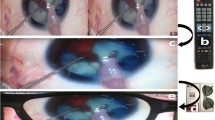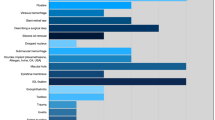Abstract
Objective
Usage of YouTube as an educational tool is gaining attention in academic research. To date, there has been no study on the content and quality of eye surgery videos on YouTube. The aim of this study was to analyze YouTube videos on phacoemulsification in eyes with small pupil.
Methods
We searched for the phrases “small pupil cataract surgery,” “small pupil phacoemulsification,” “small pupil cataract surgery complications,” and “small pupil phacoemulsification complications” in January 2015. Each resulting video was evaluated by all authors, and Krippendorff’s alpha was calculated to measure agreement. Videos were classified according to pupil size (small/very small) in the beginning of the surgery, and whether pupillary diameter was large enough to continue surgery safely after pupillary dilation by the surgeon in the video (safe/not safe). Methods of dilatation were also analyzed. Any stated ocular comorbidity or surgical complications were noted.
Results
A total of 96 videos were reviewed. No mechanical intervention for pupillary dilatation was performed in 46 videos. Fifty-eight operated eyes had no stated ocular comorbidity. Ninety-five operations ended successfully without major complication. There was fair agreement between the evaluators regarding pupil sizes (Kα = 0.670) but poor agreement regarding safety (Kα = 0.337).
Conclusions
YouTube videos on small pupil phacoemulsification have low complication rates when compared to the literature, although no reliable mechanical dilatation methods are used in almost half of these videos. Until YouTube’s place in e-learning becomes clearer, we suggest that viewers be cautious regarding small pupil phacoemulsification videos on YouTube.


Similar content being viewed by others
References
Avcı K, Çelikden SG, Eren S, Aydenizöz D (2015) Assessment of medical students’ attitudes on social media use in medicine: a cross-sectional study. BMC Med Educ 15:18
McGowan BS, Wasko M, Vartabedian BS, Miller RS, Freiherr DD, Abdolrasulnia M (2012) Understanding the factors that influence the adoption and meaningful use of social media by physicians to share medical information. J Med Internet Res 14:e117
Verhage J (2015) A bank of America analysis says YouTube is worth more than 85 percent of companies in the S&P 500. http://www.bloomberg.com/news/articles/2015-05-27/a-bank-of-america-analysis-says-YouTube-is-worth-more-than-85-percent-of-companies-in-the-s-p-500. Accessed 13 Mar 2016
Raikos A, Waidyasekara P (2014) How useful is YouTube in learning heart anatomy? Anat Sci Educ 7:12–18
Rössler B, Lahner D, Schebesta K, Chiari A, Plöchl W (2012) Medical information on the Internet: quality assessment of lumbar puncture and neuraxial block techniques on YouTube. Clin Neurol Neurosurg 114:655–658
Fischer J, Geurts J, Valderrabano V, Hügle T (2013) Educational quality of YouTube videos on knee arthrocentesis. J Clin Rheumatol 19:373–376
Guthrie G, Davies RM, Fleming CK, Browning AC (2014) YouTube as a source of information about retinitis pigmentosa. Eye (Lond) 28:499–500
Lundström M, Goh PP, Henry Y, Salowi MA, Barry P, Manning S et al (2015) The changing pattern of cataract surgery indications: a 5-year study of 2 cataract surgery databases. Ophthalmology 122:31–38
Masket S (2000) Cataract surgery complicated by the miotic pupil. In: Buratto L, Osher RH, Masket S (eds) Cataract surgery in complicated cases. SLACK Inc, Thorofare, pp 132–135
Guzek JP, Holm M, Cotter JB, Cameron JA, Rademaker WJ, Wissinger DH et al (1987) Risk factors for intraoperative complications in 1000 extracapsular cataract cases. Ophthalmology 94:461–466
Akman A, Yilmaz G, Oto S, Akova YA (2004) Comparison of various pupil dilatation methods for phacoemulsification in eyes with a small pupil secondary to pseudoexfoliation. Ophthalmology 111:1693–1698
Muhtaseb M, Kalhoro A, Ionides A (2004) A system for preoperative stratification of cataract patients according to risk of intraoperative complications: a prospective analysis of 1441 cases. Br J Ophthalmol 88:1242–1246
Chen M, LaMattina KC, Patrianakos T, Dwarakanathan S (2014) Complication rate of posterior capsule rupture with vitreous loss during phacoemulsification at a Hawaiian cataract surgical center: a clinical audit. Clin Ophthalmol (Auckland, NZ) 8:375–378
Hashemi H, Seyedian MA, Mohammadpour M (2015) Small pupil and cataract surgery. Curr Opin Ophthalmol 26:3–9
Ericsson KA (2014) Expertise. Curr Biol 24:R508–R510
Svenson O (1981) Are we all less risky and more skillful than our fellow drivers? Acta Psychol 47:143–148
Wolpe N, Wolpert DM, Rowe JB (2014) Seeing what you want to see: priors for one’s own actions represent exaggerated expectations of success. Front Behav Neurosci 8:232
Linn BS, Zeppa R (1985) Student attitudes about medical care and choice of a career in surgery. Ann Surg 202:600–666
Fanelli D (2010) Do pressures to publish increase scientists’ bias? An empirical support from US States data. PLoS ONE 5(4):e10271
Hoyt DB, Shackford SR, Fridland PH, Mackersie RC, Hansbrough JF, Wachtel TL et al (1988) Video recording trauma resuscitations: an effective teaching technique. J Trauma 28:435–440
Author information
Authors and Affiliations
Corresponding author
Ethics declarations
Conflict of interest
None.
Ethical approval
This article does not contain any studies with human participants performed by any of the authors.
Rights and permissions
About this article
Cite this article
Aykut, A., Kukner, A.S., Karasu, B. et al. Everything is ok on YouTube! Quality assessment of YouTube videos on the topic of phacoemulsification in eyes with small pupil. Int Ophthalmol 39, 385–391 (2019). https://doi.org/10.1007/s10792-018-0823-4
Received:
Accepted:
Published:
Issue Date:
DOI: https://doi.org/10.1007/s10792-018-0823-4




